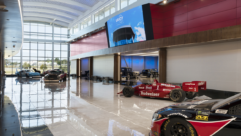

The Smithsonian Institution’s National Museum of African American History and Culture is the only national museum devoted exclusively to African American life, history, and culture. To design specialized acoustic and audio delivery solutions, exhibit designers Ralph Appelbaum Associates tapped SH Acoustics along with engineering firm Electrosonic, while museum systems specialists Design and Production, which handled fabrication, integration, and installation.
Delivering audio to tightly defined areas within large, open theaters required precise sound placement, according to SH Acoustics president and principal consultant Steve Haas, so his team relied extensively on RenkusHeinz ICONYX-series loudspeakers. “The permanent exhibits in the museum cover more than 85,000 square feet,” Haas said, “and they include media programs of all types, from large scale to hundreds of interactive exhibits, smaller experiences, touchscreens, and soundscapes. The spaces are enormous, and we had to control sound in many overlapping areas, so we had to pull every trick we knew and some we couldn’t imagine we’d utilize. Renkus-Heinz ICONYX loudspeakers gave us the beamsteering technology and high-end audio quality we needed.”
Sound for the videos is stereo, rather than surround, because the gallery theaters are so open. “We used tricks with delayed stereo to achieve immersive environments without leaking to larger areas,” relates Haas. “Renkus-Heinz ICONYX IC8-R-II and IC16-R-II loudspeakers were our choice for front program speakers because we could use their beam-steering technologies to precisely place audio with minimal leakage between exhibits and spaces. And we used them in unique ways.”
For example, Renkus-Heinz systems are employed in the fourth-floor Culture Galleries. “There’s a wide open theater with a 360-degree elliptical screen overhead,” said Haas. “You sit on benches or stand in the middle and view a custom production that wraps around you, which is very dynamic. To make stereo audio feel multidimensional, we placed six IC16- R-IIs behind the elliptical screen. Each array provides specific area coverage. We created enough of an overlap that we get even coverage, yet it feels like some sounds are present and some are distant.”
Other media experiences surround the cultural theater. “We wanted to get sound close to the people, especially those sitting on a bench,” Haas said, “So a continuous perforated screen wraps around the entire room, up high—people walk under it to get into the theater—and we spaced horizontal IC16-R-IIs around the ellipse. They aren’t evenly spaced, because of the shape of the ellipse, but ray tracing determined the exact spacing so we got good overlap.”
Complicating matters, “the exhibit designers wanted interactive stations right under the screens, facing the outside of the ellipse,” said Haas. “So we had to ensure the ICONYX weren’t in line with the interactive exhibits. Otherwise, the speakers’ vertical spread would pummel sound down on top of the interactive stations.”










